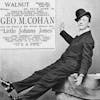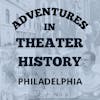[OPENING THEME]
[SFX - Recording: Paul Robeson at Carnegie Hall, May 9, 1958]
Robeson: “I’d like to do a short excerpt from Shakespeare’s Othello. It is the last speech of Othello. He has killed Desdemona - from savage passion? No. Othello came from a culture as great as that of ancient Venice, he came from an Africa of equal stature, and he felt he was betrayed. His honor was betrayed, and his human dignity was betrayed. And so when they come for him from Venice, he speaks and says:
Soft you; a word or two before you go.
I have done the state some service, and they know't.
No more of that. I pray you, in your letters,
When you shall these unlucky deeds relate,
Speak of me as I am; nothing extenuate,
Nor set down aught in malice . . “
PETER: That was the voice of Paul Robeson at New York’s Carnegie Hall on May 9, 1958. The great African American actor, singer, and political activist was doing many recordings and concerts all around the country in the mid-1950s, still waiting for his US passport to be returned so that he could once again travel the world and perform for international audiences that flocked to see his concerts and speeches in the years before the Cold War and the rise of McCarthyism had resulted in him being blacklisted and banned from doing much of the work he wanted to do in the world. A few months after this concert, however, Robeson would learn that a US Supreme Court decision had overturned the right of the government to withhold international travel of citizens for their political beliefs, and he and his wife Essie would leave for England, there to perform as Othello once again, as he had almost two decades before on Broadway. He would not return to America again for five years.
[MUSIC - “On My Journey Now”]
Hello, and welcome once again to Adventures in Theater History. It’s July 2022, and we’re doing another special summer edition of the show. In fact, Chris Colucci is on a well-deserved vacation, so I’m flying solo today. Although, as usual, our opening and ending theme music is composed by Chris, of course, all the sound editing and engineering was done by Yours Truly. So if you notice a bit of a fall-off in the sound quality of this particular episode, that should explain it. But I’m doing my very level best to wrangle things, and I promise not to skimp at all on the content.
And we’re trying another thing that’s quite different for us - we’re traveling, too - not far, but just making an on-site visit to a local Philadelphia institution with particular resonance for American theater history and the life story of Paul Robeson. So, this is a different type of sound experience we’re offering, and if it goes well, we can do more. I’m kind of excited.
Notice I don’t say Philadelphia theater history, because Robeson did not perform at this site, or in fact do anything there to attract public attention at all. I’ll explain that in a minute.
Paul Robeson did perform on Philadelphia stages during his lifetime. In the spring of 1924, as a young man, when he was just starting out as an actor, he came down from New York for one week to play at the Gibson New Dunbar Theatre on the corner of Broad and Lombard Streets. Robeson was in a show billed as a “Sensational Rural Southern Comedy Drama” called Roseanne. Also in the show was the great actress Rose McClendon. Robeson was also preparing at the time to star in two Eugene O’Neill dramas when he returned to New York, All God’s Chillun Got Wings and The Emperor Jones.
In fact, after those two shows had helped rocket Robeson to the top of the theater world’s attention and made him a major figure in the culture of the Harlem Renaissance, he came back to Philadelphia. Later that same year, in November 1924, he did a special one-show performance of The Emperor Jones at the Walnut Street Theater, where the foil character of the Englishman named “Smithers” was played with the Hedgerow Theatre’s Jasper Deeter himself.
After that Robeson did not return much to Philadelphia - in fact from 1928 to 1939 he was mostly living in London, and acting and singing all over the world - including his famous show-stopping turn singing “Old Man River” in a revival of the Jerome Kern musical Show Boat, both in London and New York. He was one of the most famous people in the world at that point, and had become fluent in multiple languages. Well-known for featuring both Negro spirituals and the folk songs of many nations in his concert repertoire, but when the outbreak of the Second World War brought him back to his home country, he thought it was important to once again investigate American folk music - and joined the company of a musical called John Henry, about the mythical steel drivin’ man. There is no extant cast recording of the show’s score, but here’s Robeson sing the well-known folk song a few years later, in a really dynamite blues recording
[MUSIC - ‘John Henry’]
In a backstage interview at the Erlanger Theatre on Market Street in December 1939, Robeson told a reporter he had turned down ten scripts in favor of this musical. "It is the sort of thing that will pave the way for a Negro theatre that some day will rank with the greatest in the world - one just as truly a part of a nation as the Comedie Francaise or the Moscow Art Theatre." Paul Robeson starred in the title role of the mythical railroad worker who "died with his hammer in his hand", along with a 60-member ensemble of African American actors. The only white member in the company was Alexander Gray, a Philadelphia-born actor.
The performances of John Henry in Philadelphia met with a very encouraging reception. However, when the show opened at the 44th Street Theatre on Broadway in January 10, 1940, it was not well received by New York critics, and ran only five nights. Apparently Robeson's wife Eslanda always had her doubts about the play, and felt the character emphasized the Black man's physical life over his intellectual development. Essie may have been secretly relieved when it closed.
In 1942, he came back to Philly and its Locust Theatre with Uta Hagen and Jose Ferrer, in the pre-Broadway tour of the great production of Othello, the first major commercial production of the play to feature a Black actor in the role with a white supporting cast. It was a sensation, both here in Philadelphia, and in its long subsequent run on Broadway, setting a standard that maybe has never been surpassed.
[RECORDING OF ROBESON AS OTHELLO]
During the rest of the 40s and 50s, Robeson would occasionally visit Philadelphia, although as far as I can tell, he didn’t do any more plays there. Sometimes he would come to do concerts, either at the Metropolitan Opera on North Broad or at the outdoor Robin Hood Dell auditorium in Fairmount Park. But mostly he would come by to drop in on the home of his sister Marian Forsythe, a public school teacher who lived in a pleasant row home on the corner of Walnut and 50th Street in West Philadelphia.
[MUSIC UNDER - “Going Home”]
It was to this home that Robeson arrived in 1966, to live with Marian once again as they had when they were children together in New Jersey. Essie has passed away. He was now 68 years old, suffering from many indignities of age and ill health, as well as the continued persecution and surveillance from the FBI. He didn’t feel up to being the public “Paul Robeson” any more, he just wanted to rest and live quietly in retirement. And for the next ten years, that’s what he did, residing in the Walnut Hill neighborhood, with Marian, until his death in January of 1976.
To take the story from there, let’s now listen to a conversation I recently had with Janice Sykes-Ross, who is the director of the West Philadelphia Cultural Alliance, an organization which currently owns and runs the Paul Robeson House and Museum, now on the National Register of Historic Places.
[NOTE: THIS INTERVIEW NOT YET TRANSCRIBED]
Previous to talking to Janice, as I mentioned in our conversation, I had already made a visit to the Paul Robeson House. My guide was Terry Fimiano Guerin, who - full disclosure - is a neighbor of mine, a former actress, director and drama teacher at the Friends Central School in Philadelphia. I arrived at the house, and Terry met me there. I could immediately see so many things about the place as I walked through the house, which is not just a lifeless museum, like so many preserved houses of Great Men that you may have seen. It’s a living and breathing place, a community resource. I could see a collection of shiny modern trophies downstairs, for instance, which I later learned belonged to the neighborhood chess club which meets there. I don’t include everything I saw in this recording of her tour - as with my interview with Ms. Sykes-Ross, I have edited the recording down for concision and content, and to take out extraneous background noise, but it was a fascinating experience. This is how it sounded:
[NOTE: THIS INTERVIEW NOT YET TRANSCRIBED]
[MUSIC - “The House I Live In”, under]
So that’s our show for today. I want to thank once again both Janice Sykes-Ross and Terry Fimiano Guerin for all the kindness, generosity and wisdom, and for helping me so much learn about the life of Paul Robeson and about how his continuing legacy in Philadelphia continues to live and expand. In a place where he once came, in some sorrow and ill-health, to retreat from the world, now due to the efforts of so many others who deeply care about his memory and his life’s work, once again there is so much to celebrate and share and learn about. I’ll put links to the website and the many amazing online resources of the West Philadelphia Cultural Alliance in the show notes, as well as a link to our own website and a blog post about Paul Robeson in Philadelphia. Please check them out if you can, and please take a look at the link for our Patreon page, now open again for new memberships and support for our work here on the podcast. Thank you all, for coming along on another Adventure in Theater History, Philadelphia.
[MUSIC - “The House I Live In”]
[END THEME]









